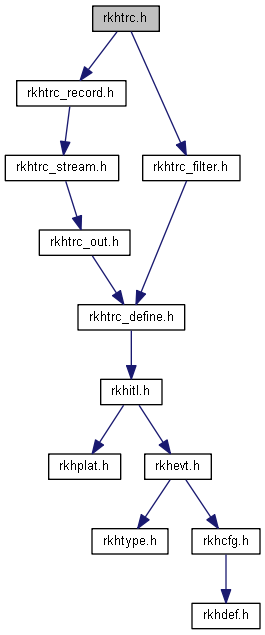Specifies the interface of trace facility.
RKH trace event structure
(2) RKH_TRC_ARG0(arg0); \
(3) RKH_TRC_ARG1(arg1); \
(4) RKH_TRC_....(...); \
- (1,5) Each trace event always begins with the macro RKH_TRC_BEGIN() and ends with the matching macro RKH_TRC_END(). These macros are not terminated with the semicolon. The record-begin macro RKH_TRC_BEGIN() takes three arguments. The first argument 'trc_evt' is the trace event ID, the second argument 'ao_prio' is the active object priority, and the third argument 'signal' is the event signal number. These arguments are used in the on/off filters. The runtime filter is optional and could be enabled or disabled with the RKH_CFG_TRC_RTFIL_EN in the rkhcfg.h file. This pair of macros locks interrupts at the beginning and unlocks at the end of each record.
- (2-4) Sandwiched between these two macros are the argument-generating macros that actually insert individual event argument elements into the trace stream.
Example:
#define RKH_TR_QUE_INIT(q, ao, nelem) \
RKH_TRC_BEGIN_WOAOSIG(RKH_TE_QUE_INITS) \
RKH_TRC_SYM(q); \
RKH_TRC_SYM(ao); \
RKH_TRC_NE(nelem); \
RKH_TRC_END()
#define RKH_TR_SMA_FIFO(actObj_, evt_, sender_, poolID_, refCntr_, \
nElem_, nMin_) \
RKH_TRC_BEGIN_NOCRIT(RKH_TE_SMA_FIFO, \
RKH_SMA_ACCESS_CONST(actObj_, prio), \
(evt_)->e) \
RKH_TRC_SYM(actObj_); \
RKH_TRC_SIG((evt_)->e); \
RKH_TRC_SNDR(sender_); \
RKH_TRC_UI8(poolID_); \
RKH_TRC_UI8(refCntr_); \
RKH_TRC_NE(nElem_); \
RKH_TRC_QUE_NMIN(nMin_); \
RKH_TRC_END_NOCRIT()
Each trace event and its arguments are placed in the trace stream like a simple data protocol frame. The protocol has been specifically designed to simplify the data management overhead in the target yet allow detection of any data dropouts due to the trace buffer overruns. The protocol has not only provisions for detecting gaps in the data and other errors but allows for instantaneous resynchronization after any error, to minimize data loss. [MS]
Frame
| ... |
(1) | event ID | 1,2,4-byte
(2) | sequence number | 1-byte
(3) | timestamp | 2,4-bytes
(4) | args | n-byte
(5) | checksum | 1-byte
(6) | flag | 1-byte
| ... |
- (1) Each frame starts with the trace event ID bytes, which is one of the predefined RKH records or an application-specific record.
- (2) Following the sequence number is the sequence number byte. The target component increments this number for every frame inserted into the stream. The sequence number allows the trazer tool to detect any data discontinuities. If the RKH_CFG_TRC_NSEQ_EN is set to 1 then RKH will add to the trace record the sequence number.
- (3) Following the sequence number is the timestamp. The number of bytes used by the timestamp is configurable by the macro RKH_CFGPORT_TRC_SIZEOF_TSTAMP. If the RKH_CFG_TRC_TSTAMP_EN is set to 1 then RKH will add to the trace record the timestamp field.
- (4) Following the timestamp is zero or more data bytes for args.
- (5) Following the data is the checksum byte. The checksum is computed over the sequence number, the trace event ID, and all the data bytes. If the RKH_CFG_TRC_CHK_EN is set to 1 then RKH will add to the trace record a checksum byte.
- (6) Following the checksum is the flag byte, which delimits the frame. The flag is the 0x7E. Only one flag is inserted between frames.
To avoid confusing unintentional flag bytes that can naturally occur in the data stream with an intentionally sent flag, the protocol uses a technique known as byte stuffing or escaping to make the flag bytes transparent during the transmission. Whenever the transmitter encounters a flag byte in the data, it inserts a 2-byte escape sequence to the output stream. The first byte is the escape byte, defined as binary 0x7D. The second byte is the original byte XOR-ed with 0x20. The transmitter computes the checksum over the sequence number, the trace event ID, and all data bytes before performing any byte stuffing.
User trace events
The user application could defined its own trace events to be placed at anywhere in the application level. Allowing to generate tracing information from the application-level code like a "printf" but with much less overhead.
(2) RKH_TRC_ARG0(arg0); \
(3) RKH_TRC_ARG1(arg1); \
(4) RKH_TRC_....(...); \
- (1,5) Each trace event always begins with the macro RKH_TRC_USR_BEGIN() and ends with the matching macro RKH_TRC_USR_END(). The record-begin macro RKH_TRC_USR_BEGIN() takes one argument, 'eid_' is the user trace event ID, from the RKH_TE_USER value. This pair of macros locks interrupts at the beginning and unlocks at the end of each record.
- (2-4) Sandwiched between these two macros are the argument-generating macros that actually insert individual event argument elements into the trace stream.
Argument-generating macros for building user trace events:
- RKH_TUSR_STR() Output formatted zero-terminated ASCII string to the trace record.
- RKH_TUSR_MEM() Output formatted memory block of up to 255 bytes to the trace record.
Example:
enum
{
LOWPWR_USR_TRACE = RKH_TE_USER,
DISCONNECTED_USR_TRACE
...
};
void
some_function(...)
{
rui8_t d1 = 255;
rui16_t d2 = 65535;
rui32_t d3 = 65535;
char *str = "hello";
}
- See also
- RKH_TRC_END()
Definition in file rkhtrc.h.
